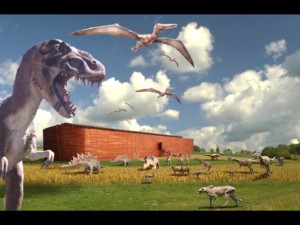 God sent air-breathing animals onto Noah’s Ark (Gen 6:20, 7:15). The “unclean” (see Deuteronomy 14:7-19 & Leviticus 11:2-31) came in pairs (a male and female) and the clean animals came in sevens – probably three male-female pairs plus one extra for Noah’s first sacrifice (Gen 8:20). This is the workweek and Sabbath pattern. As Matthew Henry noted, “God gives us six for one in earthly things, as in the days of the week,” while the seventh is “devoted to God’s honour.” The clean animals were probably domesticated animals for sacrifice, work, food and clothing. Perhaps God intended for each of Noah’s three sons to start out with a pair of each clean or domesticated kind. The clean animals likely included the sheep kind (subfamily ovis), goat kind (subfamily caprinae), cow kind (subfamily bovinae, which includes the ox, bison, yak, zebu, water buffalo, etc.), and others, which perhaps have become extinct.
God sent air-breathing animals onto Noah’s Ark (Gen 6:20, 7:15). The “unclean” (see Deuteronomy 14:7-19 & Leviticus 11:2-31) came in pairs (a male and female) and the clean animals came in sevens – probably three male-female pairs plus one extra for Noah’s first sacrifice (Gen 8:20). This is the workweek and Sabbath pattern. As Matthew Henry noted, “God gives us six for one in earthly things, as in the days of the week,” while the seventh is “devoted to God’s honour.” The clean animals were probably domesticated animals for sacrifice, work, food and clothing. Perhaps God intended for each of Noah’s three sons to start out with a pair of each clean or domesticated kind. The clean animals likely included the sheep kind (subfamily ovis), goat kind (subfamily caprinae), cow kind (subfamily bovinae, which includes the ox, bison, yak, zebu, water buffalo, etc.), and others, which perhaps have become extinct.
Genesis 6:19-22 And of every living thing of all flesh, two of every sort shalt thou bring into the ark, to keep them alive with thee; they shall be male and female. 20 Of fowls after their kind, and of cattle after their kind, of every creeping thing of the earth after his kind, two of every sort shall come unto thee, to keep them alive. 21 And take thou unto thee of all food that is eaten, and thou shalt gather it to thee; and it shall be for food for thee, and for them. 22 Thus did Noah; according to all that God commanded him, so did he.
Genesis 7:2-3, 15 Of every clean beast thou shalt take to thee by sevens, the male and his female: and of beasts that are not clean by two, the male and his female. 3 Of fowls also of the air by sevens, the male and the female; to keep seed alive upon the face of all the earth….15 And they went in unto Noah into the ark, two and two of all flesh, wherein is the breath of life.
God sent “sorts” or “kinds” of animals onto Noah’s Ark, not every species. Most Creationists consider the kinds to be fairly close to “families,” and in some cases “subfamilies,” in Linnaeus’ taxonomy.
Kingdom -> Phylum -> Class -> Order -> Family -> Subfamily -> Genus -> Species
We are looking at the vertebrates since almost all invertebrates are ocean-dwelling. The few land invertebrates such as insects and spiders could have survived the flood in egg or larvae form or on floating plant mats. Vertebrates are described in http://anthro.palomar.edu/animal/animal_4.htm).
There were four classes of vertebrates on the Ark: Amphibians, Reptiles Mammals, and Birds. The remaining classes (fish), of course did not need to go on the Ark.
Classes # of Orders # of Families (clean*) # of Genuses # of Species
Amphibians 3 44-51 (0) 434 5,500-7,000
Reptiles 4 55-60 (0) 1012 8,000-10,000
Mammals 19-26 137 (~10) 1142 4,800
Birds (Aves) 25-29 146-194 (~15) 2161 9,700-10,000+
TOTAL 51-62 382-442 (~25) 4749 28,000-31,800
Table 1. Classification amounts of extant non-fish vertebrates. Some of the above information was from http://sciencecastle.com/sc/index.php/animalspecies/showclasses.
*There were probably about 10 clean kinds of mammals. Also, perhaps about 15 kinds of birds were clean (permitted for food and used for sacrifice).
How Many Total Animals Did Noah Take into the Ark?
Although scholars are split on this issue, and it’s not a huge deal, let’s assume that Noah took seven rather than fourteen clean animals on the Ark (see article). Considering the extant (currently living, non-extinct) animals (see Table 1), we estimate 500 “kinds” (families and subfamilies) x 2 (male and female) of unclean and estimate 25 “kinds”(families and subfamilies) x 7 (one plus 3 pairs) of clean animals. This gives a total of 1175 animals. Now we must account for extinction since the time that the animals got off the Ark. This would include dinosaurs and others. If we assume a 50% extinction rate, this puts about 2350 animals on the ark. If we give a range of 30% to 70% extinction, we have a total range of about 1700 to 3900 animals on the Ark. These totals would be manageable for Noah and his family. Although God told him to take food on the Ark for his family and the animals, it is not unreasonable to consider that God could have easily slowed down the metabolism rates of theses animals or even put some of them into hibernation so that the animal maintenance would have been reduced.
After the animals came off the Ark, they multiplied and diversified. The large gene pool of information God had placed in the original Ark animals allowed for significant adaptation and speciation (some call this Natural Selection, but Nature never selects, organisms adapt). For example, all of the cat kind today, the lions, tigers, pumas, cheetahs, house cats, etc. are all descended from the single cat kind that came off the Ark.
The first eleven chapters of Genesis, which include the history of Noah and the global Flood is written in narrative Hebrew form, not as figurative poetry. We take it as literal world history. Here we see that the number of animals on the Ark was not an unmanageable number. Other studies have shown that the Ark was big enough and seaworthy enough for its monumental task. God’s message concerning the Flood is one of judgment and one we should heed, especially today (Matt 24:37). Jesus will be returning soon and this time He is returning as judge. We must all be ready. Are you? Praise God for his “marvelous works that he hath done; his wonders, and the judgments of his mouth;” Psalm 105:5.





Yeah, i totally agree. It’s nice reading your posts and i have been following them for a while now.
Please post more
Sorry for the hiatus. Just posted a new one.